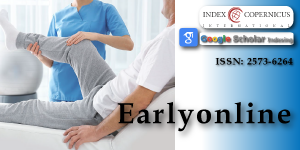Physiotherapy Rehabilitation in a 7-Year-old Male with Gait Impairment and Developmental Regression: A Case Report
Main Article Content
Abstract
This case report describes a 7-year-old male with gait impairment, frequent falls, and gross motor regression since age 4, despite normal early developmental milestones. Clinical findings included scissoring gait, bilateral lower limb hypotonia, proximal weakness, dystonic right-hand movements, and upgoing plantar reflexes, with normal neuroimaging. Differential diagnoses included cerebral palsy, hereditary spastic paraplegia, dopa-responsive dystonia, and proximal myopathy. Physiotherapy interventions focused on balance, strengthening, gait re-education, and functional independence. After a structured program (45 minutes per session, 5 days/week for 12 weeks), the child demonstrated measurable improvements in GMFM (71.78%), functional independence (FIM: 88), and gait stability, with reduced falls and improved ADL participation. This case highlights diagnostic challenges in pediatric motor disorders and underscores the essential role of physiotherapy in optimizing function despite diagnostic uncertainty.
Article Details
Copyright (c) 2025 Timalsina P, et al.

This work is licensed under a Creative Commons Attribution 4.0 International License.
1. McKeown MJ, Hutton E. Gait disorders in children: Neurological and neuromuscular causes. Paediatr Child Health. 2019;29(5):223-30.
2. Graham HK, Rosenbaum P, Paneth N, Dan B, Lin JP, Damiano DL, et al. Cerebral palsy. Nat Rev Dis Primers. 2016;2:15082. Available from: https://doi.org/10.1038/nrdp.2015.82
3. Novak I, Morgan C. Physiotherapy interventions for cerebral palsy: An evidence-based overview. Dev Med Child Neurol. 2019;61(9):1037-43.
4. Rosenbaum P, Paneth N, Leviton A, Goldstein M, Bax M. A report: The definition and classification of cerebral palsy April 2006. Dev Med Child Neurol Suppl. 2007;109:8-14. Available from: https://pubmed.ncbi.nlm.nih.gov/17370477/
5. Blackstone C. Hereditary spastic paraplegia. Handb Clin Neurol. 2018;148:633-52. Available from: https://doi.org/10.1016/b978-0-444-64076-5.00041-7
6. Nygaard TG. Dopa-responsive dystonia. Mov Disord Clin Pract. 2018;5(6):591-6.
7. Mercuri E, Muntoni F. Muscular dystrophies. Lancet. 2013;381(9869):845-60. Available from: https://doi.org/10.1016/s0140-6736(12)61897-2
8. Ghai S, Ghai I, Effenberg AO. Effect of rhythmic auditory cueing on gait in cerebral palsy: A systematic review and meta-analysis. Neuropsychiatr Dis Treat. 2018;14:43-59. Available from: https://doi.org/10.2147/ndt.s148053
9. Verschuren O, Darrah J, Novak I, Ketelaar M, Wiart L. Rehabilitation in children with cerebral palsy: Evidence-based overview. Phys Ther. 2014;94(2):297-305. Available from: https://doi.org/10.2522/ptj.20130214





